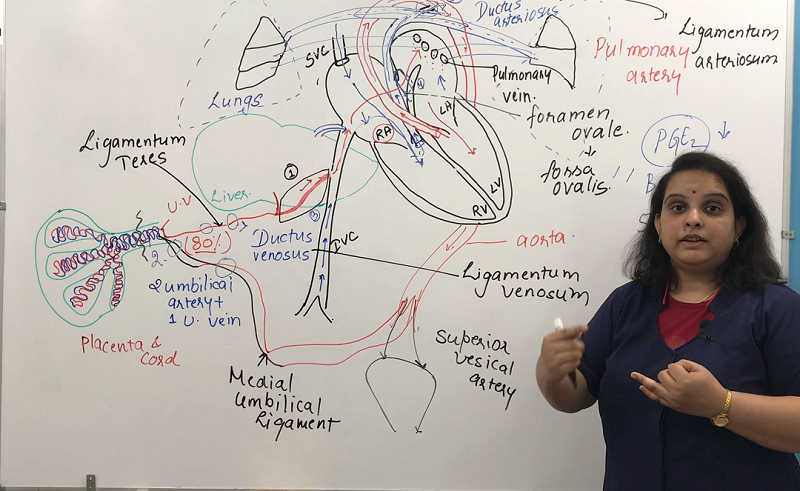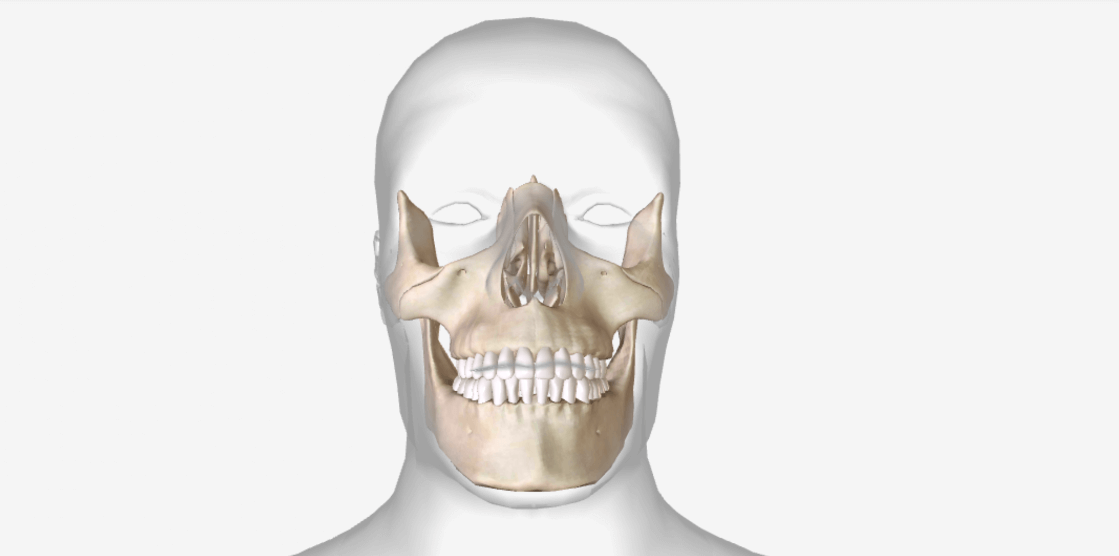Fetal circulation is the circulatory system of a fetus, It differs from normal postnatal circulation because the lungs are not functional and the fetus obtains oxygen and nutrients from the mother through the placenta and the umbilical cord by the umbilical vessels.
As breathing resumes after birth it transforms fetal circulation into postnatal circulation as in an adult manner and within 1 or 2 hours after birth, the cardiac output is about 500 ml/min.
Circulation before birth (Prenatal) –
The umbilical vein carries 80% saturated oxygenated blood from the placenta
⇩
It branches off to the left lobe of the liver and receives the deoxygenated blood from the portal vein
⇩
Half of the blood from the umbilical vein i.e.50% enters through the ductus venosus & then enters into the inferior vena cava and then to the right atrium, and the other half (50%) enters the liver proper from the inferior border of the liver and drains into inferior vena cava
⇩
Thus it mixes with fetal deoxygenated blood
⇩
From here, 75% of blood is directed through the right atrium by the foramen ovale and passes into the left atrium
⇩
It mixes with a small amount of venous blood from the lungs through the pulmonary veins
⇩
Left atrial blood is passed through the mitral opening into the left ventricle
⇩
25% blood from the right passes through the tricuspid opening into the right ventricle
⇩
Left ventricular blood is pumped into the ascending and arch of the aorta
⇩
The right ventricular blood passes into the pulmonary trunk, the resistance in the pulmonary arteries is very high as the lungs are nonfunctional, the blood passes directly through the ductus arteriosus into the descending aorta bypassing the lungs
⇩
40% of the cardiac output goes to the placenta through the umbilical arteries
⇩
Deoxygenated blood leaves the body by two umbilical arteries and reaches the placenta to gets ready for recirculation
⇩
Cardiac output is about 350 ml/kg/min
Circulation at birth (Postnatal) –
Changes occur because the blood flow stop after cutting the umbilical cord and the respiration begin soon after birth.
1. Closure of the Umbilical vein occurs after the umbilical arteries have closed, which allows the remaining 80–100 mL blood transfuse from the placenta to the fetus. Within a week of birth, the umbilical vein is completely closed.
2. Ductus venosus closes during the first week of life in full-term neonates. Functional closure occurs within minutes of birth. If the ductus venosus fails to occlude after birth, it remains open, and the individual has a patent ductus venosus.
3. Foramen ovale (foramen Botalli)- At birth, the pressure within the left atrium is higher resulting in functional closure of the valve of the foramen ovale soon after birth. Permanent anatomical closure of the foramen ovale in about 1 year. There is a septum primum, a crescent-shaped piece of tissue between the right and left atria, its shape does not fully occlude the space between the left and right atria, the septum secundum in the right side leaves a small opening called the foramen ovale. It opens and closes in response to pressure gradients, When the pressure is greater in the right atrium, the valve opens, Because the lungs are nonfunctional in fetal life, pressure in the pulmonary circulation is greater than that of the systemic circulation.
4. The ductus arteriosus (ductus Botalli) is a blood vessel in the developing fetus connecting the trunk of the pulmonary artery to the proximal descending aorta. The prostaglandins are responsible for maintaining the openness of the ductus arteriosus by dilating the vascular smooth muscle throughout the fetal period, which is produced by the placenta and the ductus arteriosus. PGE1 and PGE2 keep the ductus arteriosus open. Immediately after birth, the levels of both PGE2 and the EP4 receptors reduce that allowing for closure of the DA and establishment of normal postnatal circulation. Thus functional closure occurs soon after the birth but anatomical closer takes about 1–3 months.
5. The paired umbilical artery surrounds the urinary bladder and then carries the deoxygenated blood out of the fetus through the umbilical cord. Functional closure is instant preventing a slight amount of the fetal blood to drain out. Anatomical closure occurs about 2–3 months later.
Remnants –
-The umbilical vein forms the ligamentum teres later it becomes a round ligament of the liver.
-The ductus venosus becomes ligamentum venosum.
-Ductus arteriosus closes and becomes ligamentum arteriosum. Failure of the ductus arteriosus to close after birth results in a condition called patent ductus arteriosus, which results in the abnormal flow of blood from the aorta to the pulmonary artery. It may be induced by the administration of nonsteroidal anti-inflammatory drugs (NSAIDs), that inhibit prostaglandin production, the commonest is Indomethacin, which is usually administered in the first week after birth.
-A portion of the umbilical artery obliterates to become the medial umbilical ligament. A portion remains open as a branch of the anterior division of the internal iliac artery and this gives rise to the superior vesical arteries.
–Fossa ovalis is a depression in the right atrium of the heart, is the remnant of a thin fibrous sheet that covered the foramen ovale during fetal development.
Download the App: Android App
For more Lectures, please visit-
YouTube Channel – NursingLecture
Facebook – Facebook Page



